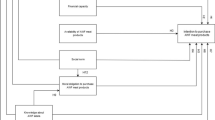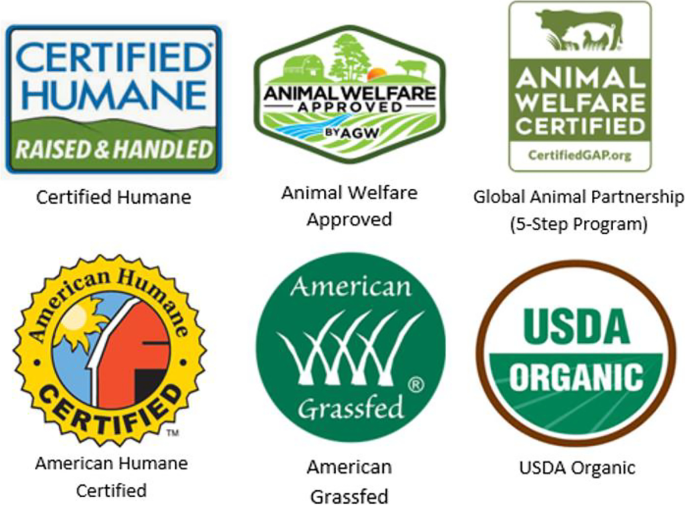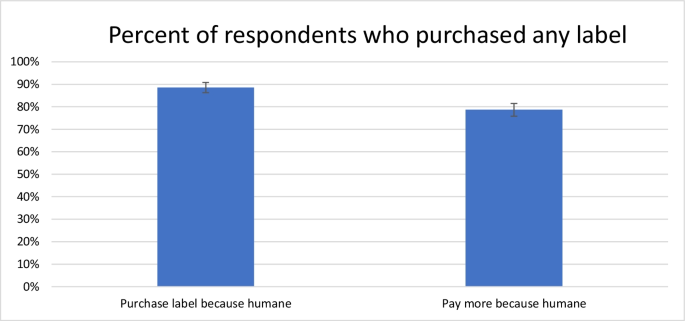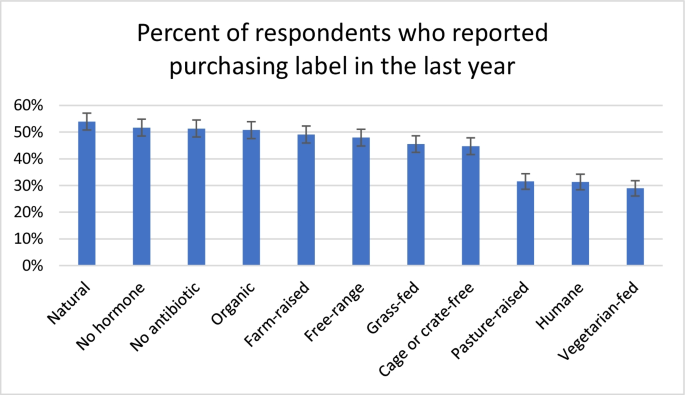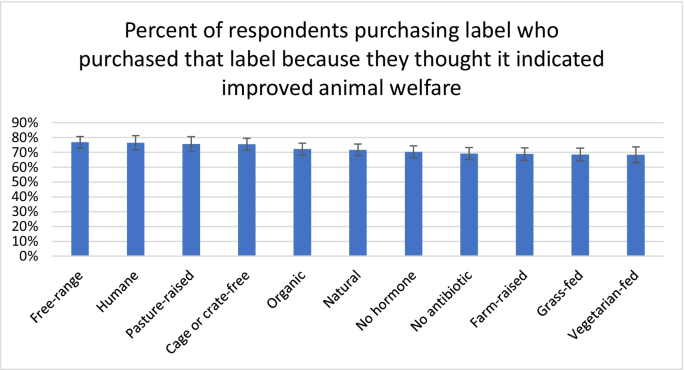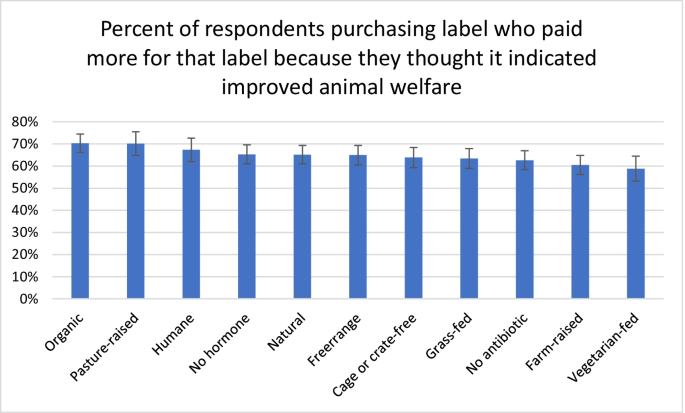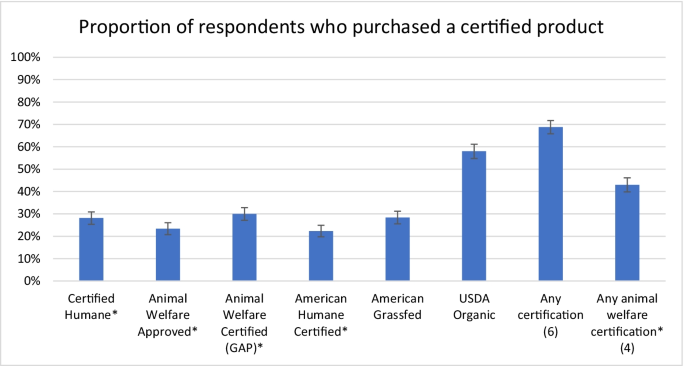Abstract
There is widespread and growing concern among U.S. consumers about the treatment of farmed animals, and consumers are consequently paying attention to food product labels that indicate humane production practices. However, labels vary in their standards for animal welfare, and prior research suggests that consumers are confused by welfare-related labels: many shoppers cannot differentiate between labels that indicate changes in the way animals are raised and those that do not. We administered a survey to 1,000 American grocery shoppers to better understand the extent to which consumers purchase and pay more for food with certain labels based on an assumption of welfare improvement. Results showed that 86% of shoppers reported purchasing at least one product with the following labels in the last year: “cage or crate-free”, “free-range”, “pasture-raised”, “natural”, “organic”, “no hormone”, “no antibiotic”, “no rBST”, “humane”, “vegetarian-fed”, “grass-fed”, “farm-raised”. Of those who purchased one of the aforementioned labels, 89% did so because they thought the label indicated higher-welfare production practices, and 79% consciously paid more for the product with the label because they thought that the label indicated better-than-standard animal welfare. However, many of these labels lack uniform standards for the production practices they represent, and some labels represent production practices that do not influence animal welfare, thus the degree of the animal welfare impact of a given label is highly variable. These results indicate that labels need to clearly and accurately specify their animal welfare benefits to improve the consumers’ ability to purchase products that align with their expectations.
Similar content being viewed by others
Introduction
Research has demonstrated widespread and growing concern among U.S. consumers about the treatment of farmed animals (Prickett et al. 2010). According to a recent national study, 78% of respondents reported being somewhat or very concerned about the welfare of animals being raised for food (Spain et al. 2018). Research has also reported that almost half (49%) of respondents somewhat or strongly agreed that they consider the well-being of farm animals when making animal-sourced foods (ASF) purchase decisions (Prickett et al. 2010). There has also been a consistent increase in the past several years in the number of U.S. consumers who prefer eggs, meat, and dairy products from higher-welfare production systems (Holger et al. 2008; Janssen et al. 2016; Lusk et al. 2007) and are willing to pay more for eggs, meat, and dairy products that come from humanely treated animals (Heng et al. 2016; Janssen et al. 2016; Lusk et al. 2007; Ortega & Wolf 2018).
Because consumers generally cannot observe production practices, they rely upon labels for this information. Indeed, consumers are paying attention to food product labels that indicate humane production practices (Spain et al. 2018). While many labels communicate about animal welfare attributes, not all labels have consistent and required standards, and the degree of improvement to animals’ lives can vary by both label and the type of animal product bearing a given label. In many cases, the company may create its own standard against which they are measured (FSIS - USDA 2019; Sullivan 2013a), thus any improvements in animal welfare vary substantially within a given label. In other cases, labels do not represent any improvement in animal welfare, despite consumers’ assumptions that they do. These conditions can lead to consumer confusion about which labels represent improvements in animal welfare over a conventional product, and to what extent.
Our aim with this research was to describe U.S. consumers' use of labels to identify improvements in animal welfare over a conventional product. We captured this by collecting data on the proportion of consumers who both purchased and paid more for products with labels because they thought the label indicated higher-welfare production practices. This information helps us to better understand if and how the current label scheme provides sufficient information to consumers about animal welfare and the extent to which there is a disconnect between consumers' expectations of the animal welfare benefit of a label and the welfare benefit the label renders.
A survey was administered to 1,000 U.S. grocery shoppers, aimed at attaining data about consumers’ past-year purchases of ASF with welfare-related labels and what portion of those consumers made those purchases because they thought the label ensured higher-welfare production practices. We asked respondents whether they purchased a product with this label, whether they purchased that product because they thought the label indicated higher-welfare production practices, and whether they knowingly paid more for the product with the label because they thought it indicated higher-welfare production practices. Additionally, we analyzed to what extent these same consumers purchased products with animal welfare certifications that represent consistent and measurable higher-welfare production practices because they have established standards and are verified by third-party audits.
Background from Past Research
In general, labels communicate information about products to consumers, some of which are unobservable attributes such as production processes (Darby & Karni 1973). The increasing distance between ASF (animal-sourced food) production and consumption causes consumers to rely heavily on labels to inform food purchasing decisions (Hepting et al. 2014). However, the information provided through a label can be limited and consumers may make inaccurate assumptions about what that label represents (Abrams et al. 2010; Kuchler et al. 2020). For instance, many consumers inaccurately equate the “natural” label with no antibiotics or hormones and/or the use of organic production practices (Abrams et al. 2010; Kuchler et al. 2020).
Another reason for this gap is consumers' lack of understanding of modern farming practices and how they impact welfare (Harper & Makatouni 2002). For instance, consumers underestimate the proportion of eggs produced from hens in battery cages (Norwood & Lusk 2011; Prickett et al. 2010), and wrongly assume that broiler (meat-type) chickens are raised in cages versus cage-free (Lusk 2018). Consumers also inaccurately assume that hormones are often used in egg, chicken, and turkey production and are willing to pay more for the hormone-free label despite the fact that federal regulations prohibit the use of hormones in these products’ production (Yang et al. 2017).
Welfare benefits of a given label also vary based on the product type and consumers cannot distinguish between products that bear the same label but represent different animal welfare benefits for different ASF products (Sullivan 2013b). For instance, the “cage-free” label on chicken indicates no additional allowances because broiler chickens are not typically raised in cages in the U.S. Conversely, eggs labeled “cage-free” were produced by layers not confined to cages, which is an improvement from the standard practice of confining multiple hens to small “battery” cages (Lusk 2018).
Another source of misunderstanding arises from inconsistent animal welfare standards or enforcement mechanisms for labels. For instance, companies and producers can label ASF as “humane” based upon their own definitions of humane production practices, which may be no different from standard production practices (FSIS - USDA 2019). Likewise, outdoor access requirements for the “free-range” label are unspecified and have no minimum space requirements (FSIS - USDA 2019); therefore, the quality and duration of outdoor access may vary dramatically across farms.
Figure 1 provides the standards required for label use, the managing authority, and the welfare implications of the subset of labels focused on in this study. In the cases of “cage-free” on meat birds, “crate-free”, “farm-raised”, and “humane/humanely-raised”, there is no official standard defined by the USDA; producers set their own definitions and share documentation with the USDA Food Safety and Inspection Service (FSIS) which verifies adherence to this standard through the label pre-approval process on a case-by-case basis (FSIS - USDA 2019). There is no on-farm audit required to use these labels.
For other labels, standards are set for the use of the label on some product types but not others, so the impact of the label varies based on the product upon which it appears. In the case of “natural”, the USDA standards apply to meat and poultry, and require that (1) the product does not contain any artificial flavor or flavoring, coloring ingredient, or chemical preservative, or any other artificial or synthetic ingredient; and (2) the product and its ingredients are not more than minimally processed (neither of which impact animal welfare). However, there is no such definition for the use of the “natural” label on eggs and dairy, but it is still used. Similarly, the “no hormone” label is regulated by the USDA, however, hormones are legally prohibited from use on chickens and turkeys, thus the label only represents a change in production practices for pork, dairy, and beef cattle.
For other labels, there are limited standards required to use the label, so again the welfare impact varies broadly. For the use of the “free-range” label on poultry and beef, the USDA establishes some standards but does not specify the size, duration, or quality of the outdoor space which means conditions will vary dramatically between farms (as will the welfare impact). Similarly for the use of the “cage-free” label on eggs, while hens cannot be confined to cages, the guidance falls short of defining space and outdoor access requirements. As a result, conditions for these animals vary broadly by farm.
Of the labels included in this study, only one, “organic,” has animal welfare standards that are both broadly defined and enforced. Organic is a federally regulated program with measurable, publicly available standards that are audited on-farm regularly. The USDA definition of “organic” requires animals to have continuous access to pasture year-round, which likely ensures that the animals have spent some portion of their lives outdoors, which has inherent welfare benefits over continual confinement. However, “access” is not clearly defined (e.g. number of access points, amount, or quality of pasture), therefore animals may still be confined in high densities (USDA Agricultural Marketing Services 2017).
Materials and Methods
Survey
To better understand if the current label scheme effectively communicates information about animal welfare to consumers we utilized a cross-sectional survey to determine the proportion of U.S. consumers who purchased and paid more for ASF products with a given label because of their expectation that it represents higher-welfare production practices. We, in collaboration with Lake Research Partners, surveyed 1000 U.S. consumers of animal-sourced foods (ASF: meat, eggs, and dairy products) from January 15–23, 2020 to identify purchasing and perceptions of ASF product labels. Survey respondents included members of consumer panels who previously volunteered to participate in market research. Participants were emailed an invitation to complete an internet-based survey. Respondents eligible for the survey were U.S. residents 18 years old and older who indicated that they were the primary or co-primary grocery shopper of the household and had purchased at least some ASF for their households in the last year.
The survey consisted of questions about consumers’ level of concern about the welfare of animals raised for food, whether they purchase ASF products with welfare-related labels, whether they purchase ASF products with welfare-related third-party certification, if they would switch to an ASF product with a certification that guaranteed a higher animal welfare standard, and their desire for government regulations surrounding animal welfare food labeling (See Supplemental Materials for the full survey). To reduce the likelihood of preferentially selecting respondents with positive attitudes towards animal welfare, the survey invitation did not mention animal welfare and instead indicated that the topic was “issues that people have been discussing recently about food, eating, and shopping habits,” and no questions related to animal welfare were provided until after the respondent was determined to be eligible for the study.
To ensure the sample population represented the population of national shoppers, responses were weighted slightly by gender, age, region, race, political party identification, and education. Survey question responses with four or more categories were collapsed into two categories to facilitate analysis. For instance, responses “very likely” and “somewhat likely” were combined as “likely,” and “not very likely” and “not at all likely” were combined as “unlikely”. Responses were summarized as proportions with exact 95% confidence intervals for binomial proportions using the Clopper-Pearson method. All statistical analyses were conducted in Stata (StataCorp. 2017. Stata Statistical Software: Release 15. College Station, TX: StataCorp LLC).
Labels
Respondents were asked about past 12-month purchasing of the following labels: “cage or crate-free”, “free-range”, “pasture-raised”, “natural”, “organic”, “no hormone”, “no antibiotic”, “no rBST”, “humane”, “vegetarian-fed”, “grass-fed”, and “farm-raised”. Consumers were also asked if they were currently buying ASF with the following certifications: Certified Humane, Animal Welfare Approved, Animal Welfare Certified (GAP), American Humane Certified, American Grassfed Association, and USDA Organic (Fig. 2). These certifications vary in their requirements and the types of farming systems they allow, but in contrast to the claims listed above, these programs each have multi-pronged, publicly-available standards which include prohibitions on common, conventional practices that impact animals’ welfare, regular on-farm audits, and enforcement of standards.
Results
More than three-fourths of our sample (76%) of consumers reported that they were the primary grocery shopper, and the remaining 24% reported they shared equal grocery shopping responsibility in their household. This sample generally reflects the characteristics of household grocery shoppers published elsewhere (Ortega & Wolf 2018; Spain et al. 2018) (Table 1). Compared with the general U.S. population, this weighted sample had slightly more females than males and more households with children. This sample was also older, with more education and lower-income than the general U.S. population.
Ninety-six percent (CI 94–97%) of respondents reported purchasing meat, 95% (CI 93–96%) reported purchasing eggs, and 96% (CI 95–98%) reported purchasing dairy at least once per month in the last year. Seventy-six percent (CI 73–78%) of respondents reported they were somewhat or very concerned about animal welfare. Eighty-six percent (CI 84–89%) reported purchasing at least one of the following labels in the last year: “cage or crate-free”, “free-range”, “pasture-raised”, “natural”, “organic”, “no hormone”, “no antibiotic”, “no rBST”, “humane”, “vegetarian-fed”, “grass-fed”, and “farm-raised”. Of those who purchased one of the aforementioned labels, 89% (CI 86–91%) did so because they thought the label indicated higher-welfare production practices, and 79% (CI 76–82%) consciously paid more for the label because they thought that the label indicated higher-welfare production practices (Fig. 3). Sixty-nine percent (CI 65–72%) reported purchasing a third-party certified egg, meat, or dairy product, and 43% (CI 40–46%) reported purchasing egg, meat, or dairy products with a third-party certification specifying animal welfare in the label (Certified Humane, Animal Welfare Approved, Animal Welfare Certified (GAP), American Humane Certified). Eighty-three percent (CI 80–85%) of respondents reported they would be likely to switch to a meat, egg, or dairy brand that guaranteed that the products came from farm animals raised under higher animal welfare standards. Eighty-five percent of respondents (CI 82–87%) reported that they thought the government should be setting and enforcing clear definitions for food labels related to animal welfare.
The proportion of respondents who purchased a given label varied across labels (Fig. 4); 29% reported that they purchased the vegetarian-fed label and as many as 54% purchased the “natural” label. The vast majority of consumers reported they purchased a given label because they thought that label indicated higher-welfare production practices (Fig. 5) and reported paying more for a given label because they thought the label indicated higher-welfare production practices (Fig. 6).
Because of variation in the availability, meaning, and regulation of labels across product types, we disaggregated the percent of individuals who reported purchasing a given label across labels and ASF product type (Appendix Table 5), the percent of individuals who reported purchasing a label because they thought the label indicated higher-welfare production practices (Table 2), and the percent of individuals who reported paying more for a label because they thought the label indicated higher-welfare production practices (Table 3). Across all labels and product types, most consumers who reported purchasing a specific label did so with the intention of purchasing a higher welfare product (Table 3). In some cases, such as “organic” chicken, “humane” dairy, and “pasture-raised” eggs, at least three-quarters of consumers purchasing those labels did so because they thought that label indicated higher-welfare production practices.
Figure 7 shows the proportion of respondents who reported that they purchased meat, egg, or dairy products with one of the six certification labels: Certified Humane, Animal Welfare Approved, Animal Welfare Certified (GAP), American Humane Certified, American Grassfed Association, or USDA Organic. Sixty-nine percent (CI 66–72%) of respondents reported purchasing at least one of the six certifications, and 43% (CI 40–46%) reported purchasing one or more of the four certifications that specify higher-welfare production practices: Certified Humane, Animal Welfare Approved, Animal Welfare Certified (GAP), American Humane Certified.
Several certification labels contain terms that are also used in generic labels. “Certified Humane” and “American Humane Certified” contain the term “humane”; “USDA Organic” contains the term “organic”; “American Grassfed Association” contains the term “grass-fed.” To identify the extent to which consumers purchase third-party certifications and also generic labels that do not adhere to the same standards, we calculated the proportion of respondents who reported purchasing a broader, generic label as a proportion of those purchasing the certified label. Of those who reported purchasing the “grass-fed” label, 42% (CI 38–47%) also reported that they purchase ASF products with the “American Grassfed Association” certification. Of those who reported purchasing a “humane” or “humanely-raised” label, 53% (CI 47–58%) also reported that they purchased meat, egg, or dairy products with the “Humane Certified” certification and 42% (CI 36–47%) reported they purchased meat, egg, or dairy products with the “American Humane Certified” certification.
To identify the extent to which consumers who purchase third-party certifications also purchase non-certified labels with the intention of purchasing a higher welfare product, we calculated the proportion of respondents who reported purchasing a certified product who also purchased a label because they thought that label indicated higher-welfare production practices. Of those who reported that they purchased meat, eggs, or dairy products with one of the four certifications that specify animal welfare (Certified Humane, Animal Welfare Approved, Animal Welfare Certified (GAP), American Humane Certified), up to 59% (CI 54–64%) reported also purchasing a non-certified label because they thought it indicated humane treatment and up to 58% (CI 53–62%) reported paying more for a non-certified label because they thought it indicated higher-welfare production practices (Table 4).
Discussion
Our results show that 86% of surveyed consumers reported purchasing at least one product with a welfare-related label in the past 12 months, 89% of those reported doing so because they believed the label indicated better than standard animal welfare, and 78% paid more for the label because they thought the label indicated higher-welfare production practices. In addition, a majority of respondents who reported purchasing one of the four animal welfare-related certifications also purchased products with non-certified labels assuming those labels indicated improved animal welfare. For example, we found that of consumers who reported purchasing animal welfare certified products, 59% also reported purchasing the “natural” label because they believed it represented improved animal welfare standards. These findings suggest that consumers are largely unaware of the differing impact between certifications and these welfare-related labels.
These findings are consistent with several studies that demonstrate consumers incorrectly associate many labels with improved animal welfare, and that consumers seek out and pay more for these labels, even when these labels may not represent higher-welfare production practices (Abrams et al. 2010; Dominick et al. 2017; Malone & Lusk 2016; Ochs et al. 2019). Despite the fact that the “natural” claim does not address production practices for ASF, 60% of consumers associated the “natural” claim with “improved animal handling/animal welfare practices” (Dominick et al. 2017). Consumer perceptions of labels and the production practices they represent are often inaccurate; only 5.6% of respondents accurately understood the impact of free-range systems on hen health and stress compared with conventional systems and, similarly, only 6.9% accurately understood the impact of cage-free (Ochs et al. 2019).
Consumers are motivated to seek out and pay more for improved animal welfare and must rely upon labels to provide additional information about the conditions in which animals are raised to achieve their goals (Alonso et al. 2020; Janssen et al. 2016; Napolitano 2008; Spain et al. 2018). For voluntary labels to effectively serve the market for improved animal welfare practices, consumers need to be able to distinguish the animal welfare benefits associated with a given label (Sullivan 2013a; Sunstein 2016). Additionally, this lack of measurable characteristics does not facilitate comparison between products. As a result, consumers' interpretation of process labels is left to be influenced by their beliefs, which opens the door to misunderstanding or misattributing improved welfare (Messer et al. 2017).
Our findings provide evidence that consumers cannot differentiate between labels that indicate higher-welfare production practices from those that don’t, suggesting that voluntary labels are not effectively communicating improvements in animal welfare to consumers. Because consumers cannot make this distinction, they may seek out and pay more for an attribute (such as improved animal welfare) that is not present, ultimately decreasing consumer welfare and undermining the market for animal welfare (Sunstein 2016).
These information asymmetries also impact the market overall, as they can cause consumer mistrust in labels ultimately leading to market failure (Akerlof 1970). ASF producers have little incentive to exceed the minimum standard required to use these labels when they can receive a price premium without modifying their production practices (Baksi et al. 2017; Darby & Karni 1973). When producers can use a label and charge a price premium without adhering to any different standards, there is no incentive to adopt different practices, penalizing those who are increasing their costs by shifting production practices to improve animal welfare (Akerlof 1970; Kehlbacher 2012). To incentivize producers to adopt humane practices and to enable consumers to make informed decisions surrounding humane ASF purchases, labels need to reliably communicate accurate information about humane production practices to consumers (Harvey & Hubbard 2013; Sullivan 2013a; Sunstein 2016).
Government oversight and labels regulation could facilitate clear definitions of standards required to use a specific label, which could improve the communication of animal welfare benefits that a label represents to consumers (Messer et al. 2017). Studies have shown that both producers and consumers are in favor of mandatory regulation of labels through government oversight (Lusk 2019; Roe & Sheldon 2007; Wolf et al. 2016). Our results also show strong support for government regulation of animal welfare labels; 85% of respondents of our survey thought that the government should be setting and enforcing clear definitions for food labels related to animal welfare.
Including additional information or detail about production practices on labels may also alleviate consumer confusion, however, additional information may cause other issues. Research has shown that excessive information may cause overload, and crowd out other important information (such as nutritional facts) which could negatively impact consumer welfare (Lusk & Marette 2012). One possible solution may be to use technology to make additional information available to those consumers who want it (Messer et al. 2017) which recommends the use of Quick Response (QR) codes on labels. This approach could make information about animal welfare standards available to consumers who want it, without adding it directly to the packaging or label. Thus consumers will be able to access accurate, reliable information about animal welfare standards and select products accordingly (Messer et al. 2017).
Limitations
One limitation of this study is that consumers may not remember details of purchases over a 12-month period, including the reasoning behind those purchases or if they paid more. For example, the proportion of individuals who reported they paid more for grass-fed pork because they thought the label indicated higher-welfare production practices was higher than the proportion who reported purchasing it because they thought the label indicated higher-welfare production practices. Presumably, those who paid more for a label for its animal welfare benefits also purchased that label because of its animal welfare benefits. Some certification labels contain the same terms that are used in the subset of labels studied. The terms “humane”, “grass-fed” and “organic” are all used in both certifications as well as labels, and, as a result, consumers could have been confused about whether they purchased the certifications or the labels with these terms. Additionally, respondents could be more likely to over-report purchases and the drivers behind those purchases if they perceive that response to be more favorably looked upon (Edwards 1990).
We also did not explore the level of quality of welfare improvement that motivated the purchase, only that consumers were motivated to purchase because they believed the label indicated higher-welfare production practices. Nor did we capture the premium consumers are willing to pay for welfare-related labels. It would be helpful for future research to quantify the specific amount consumers pay over conventional prices for welfare-related labels because they believe the label indicates improved animal welfare standards.
Conclusion
While a substantial proportion of consumers who report purchasing these labels do so because they believe they indicate higher-welfare production practices, these labels frequently do not have set standards for production practices that improve animal welfare. This finding demonstrates that labels do not provide sufficient information to consumers to enable them to purchase products that align with their preferences for higher welfare ASF products. Our recommendation would be for federal regulations that set clear and specific standards for use of welfare-related labels, similar to the standard framework used by animal welfare certifications. Additionally, we would recommend that enforcement of these standards be accomplished through on-farm audits, either provided by the USDA or a third party. These provisions would ensure that improvements to production practices would be consistent and comparable, improving consumers' ability to compare products and purchase in line with their preferences. This change would also serve to incentivize and reward producers who use production practices that improve animal welfare, thus benefiting the overall market for animal welfare.
References
Abrams, K.M., C.A. Meyers, and T.A. Irani. 2010. Naturally confused: Consumers’ perceptions of all-natural and organic pork products. Agriculture and Human Values 27 (3): 365–374. https://doi.org/10.1007/s10460-009-9234-5.
Akerlof, George A. 1970. “The Market for Lemons: Qualitative Uncertainty and the Market Mechanism”. Quarterly Journal of Economics 84 (3): 488–500.
Alonso, M.E., J.R. González-Montaña, and J.M. Lomillos. 2020. Consumers’ concerns and perceptions of farm animal welfare. Animals 10 (3): 1–13. https://doi.org/10.3390/ani10030385.
Baksi, S., P. Bose, and D. Xiang. 2017. Credence Goods, Misleading Labels, and Quality Differentiation. Environmental and Resource Economics 68 (2): 377–396. https://doi.org/10.1007/s10640-016-0024-4.
Bauman, D.E., and R.J. Collier. 2014. Update on human health concerns of recombinant bovine somatotropin use in dairy cows. Journal of Animal Science 4: 1800–1807. https://doi.org/10.2527/jas.2013-7383.
Brunberg, E.I., T. Bas Rodenburg, L. Rydhmer, J.B. Kjaer, P. Jensen, and L.J. Keeling. 2016. Omnivores going astray: A review and new synthesis of abnormal behavior in pigs and laying hens. Frontiers in Veterinary Science 3 (JUL): 1–15. https://doi.org/10.3389/fvets.2016.00057.
Cusimano, C. 2008. RBST, It Does a Body Good: RBST Labeling and the Federal Denial of Consumers’ Right to Know. Santa Clara L. Rev., 48, 1095.
Darby, M.R., and E. Karni. 1973. Free Competition and the Optimal Amount of Fraud Author ( s ): Michael R . Darby and Edi Karni Published by : The University of Chicago Press for The Booth School of Business , University of Chicago and The University of Chicago Law School Stable URL : ht. The Journal of Law and Economics Economics 16 (1): 67–88.
Dominick, S.R., C. Fullerton, N.J.O. Widmar, and H. Wang. 2017. Consumer Associations with the “All Natural” Food Label. Journal of Food Products Marketing 24 (3): 249–262. https://doi.org/10.1080/10454446.2017.1285262.
Edwards, A. L. 1990. Construct validity and social desirability. American Psychologist 45 (2): 287–289. https://doi.org/10.1037/0003-066X.45.2.287.
FDA. 1994. Food and Drug Administration. Interim guidance on the voluntary labeling of milk and milk products from cows that have not been treated with recombinant bovine somatotropin. Federal Register 59(28): 6279–6280.
FSIS - USDA. 2019. Food safety and inspection service labeling guideline on documentation needed to substantiate animal raising claims for label submissions. December 2019, p. 1–18. https://www.fsis.usda.gov/sites/default/files/media_file/2021-02/RaisingClaims.pdf
Grandin, T. 2016. Evaluation of the welfare of cattle housed in outdoor feedlot pens. Veterinary and Animal Science 1–2 (October): 23–28. https://doi.org/10.1016/j.vas.2016.11.001.
Harper, G.C., and A. Makatouni. 2002. Consumer perception of organic food production and farm animal welfare. British Food Journal 104: 287–299. https://doi.org/10.1108/00070700210425723.
Hartcher, K.M., and B. Jones. 2017. The welfare of layer hens in cage and cage-free housing systems. World’s Poultry Science Journal 73 (4): 767–781. https://doi.org/10.1017/S0043933917000812.
Harvey, D., and C. Hubbard. 2013. Reconsidering the political economy of farm animal welfare: An anatomy of market failure. Food Policy 38 (1): 105–114. https://doi.org/10.1016/j.foodpol.2012.11.006.
Heng, Y., H.H. Peterson, and X. Li. 2016. Consumer Responses to Multiple and Superfluous Labels in the Case of Eggs. Journal of Food Distribution Research 47 (2): 62–82.
Hepting, D.H., J. Jaffe, and T. Maciag. 2014. Operationalizing Ethics in Food Choice Decisions. Journal of Agricultural and Environmental Ethics 27: 453–469. https://doi.org/10.1007/s10806-013-9473-8.
Hernandez-Mendo, O., M.A.G. Von Keyserlingk, D.M. Veira, and D.M. Weary. 2007. Effects of Pasture on Lameness in Dairy Cows. Journal of Dairy Science 90 (3): 1209–1214. https://doi.org/10.3168/jds.S0022-0302(07)71608-9.
Herring, J. L., Martin, J. M., Hudson, M. D., Nalley, L. L., & Rogers, R. W. 2007. Consumer Acceptance of “Farm Raised” Precooked Roast Beef. Journal of food quality 30 (3): 403–412.
Holger, S., F. Albersmeier, and J. Gawron. 2008. Heterogeneity in the Evaluation of Quality Assurance Systems: The International Food Standard (IFS) in European Agribusiness. International Food and Agribusiness Management Review 11 (3): 99–139.
Iannetti, L., Romagnoli, S., Cotturone, G., & Vulpiani, M. P. (2021). Animal Welfare Assessment in Antibiotic-Free and Conventional Broiler Chicken. Animals, 1–11. https://doi.org/10.3390/ani11102822
Janssen, M., M. Rödiger, and U. Hamm. 2016. Labels for Animal Husbandry Systems Meet Consumer Preferences: Results from a Meta-analysis of Consumer Studies. Journal of Agricultural and Environmental Ethics 29 (6): 1071–1100. https://doi.org/10.1007/s10806-016-9647-2.
Karavolias, J., M.J. Salois, K.T. Baker, and K. Watkins. 2017. Raised without antibiotics : Impact on animal welfare and implications for food policy. Journal of Animal Science 1: 337–348. https://doi.org/10.1093/tas/txy016.
Kehlbacher, A. 2012. Measuring the consumer benefits of improving farm animal welfare to inform welfare labelling. Food Policy 37: 627–633.
Kuchler, F., M. Bowman, M. Sweitzer, and C. Greene. 2020. Evidence from Retail Food Markets That Consumers Are Confused by Natural and Organic Food Labels. Journal of Consumer Policy 43 (2): 379–395. https://doi.org/10.1007/s10603-018-9396-x.
Ludwiczak, A., E. Skrzypczak, J. Składanowska-Baryza, M. Stanisz, P. Ślósarz, and P. Racewicz. 2021. How housing conditions determine the welfare of pigs. Animals 11 (12): 1–16. https://doi.org/10.3390/ani11123484.
Lusk, J.L. 2019. Consumer perceptions of healthy and natural food labels. A Report Prepared for the Corn Refiners Association.
Lusk, Jayson L. 2018. Consumer preferences for and beliefs about slow growth chicken. Poultry Science 97 (12): 4159–4166. https://doi.org/10.3382/ps/pey301.
Lusk, Jayson L., & Marette, S. (2012). No Can Labeling and Information Policies Harm Consumers? Journal of Agricultural & Food Industrial Organization, 10(1). https://doi.org/10.1515/1542-0485.1373
Malone, T., and J.L. Lusk. 2016. Putting the Chicken before the Egg Price : An Ex Post Analysis of California ’ s Battery Cage Ban. Journal of Agricultural and Resource Economics 41 (3): 518–532. https://doi.org/10.22004/ag.econ.246252.
Messer, K.D., M. Costanigro, and H.M. Kaiser. 2017. Labeling food processes: The good, the bad and the ugly. Applied Economic Perspectives and Policy 39 (3): 407–427. https://doi.org/10.1093/aepp/ppx028.
Napolitano, F. 2008. Effect of Information About Animals Welfare on Consumer Willingness to Pay for Yogurt. Journal of Dairy Science 91: 910–917.
Norwood, F.B., and J.L. Lusk. 2011. A calibrated auction-conjoint valuation method : Valuing pork and eggs produced under differing animal welfare conditions. Journal of Environmental Economics and Management 62 (1): 80–94. https://doi.org/10.1016/j.jeem.2011.04.001.
Ochs, D., C.A. Wolf, N.O. Widmar, C. Bir, and J. Lai. 2019. Hen housing system information effects on U. S. Egg Demand. Food Policy 87 (May).
Ortega, D.L., and C.A. Wolf. 2018. Demand for farm animal welfare and producer implications: Results from a field experiment in Michigan. Food Policy 74 (November 2017): 74–81. https://doi.org/10.1016/j.foodpol.2017.11.006.
Pietrosemoli, S., and C. Tang. 2020. Animal Welfare and Production Challenges Associated with Pasture Pig Systems : A Review. Agriculture 10: 1–34.
Prickett, R.W., F.B. Norwood, and J.L. Lusk. 2010. Consumer preferences for farm animal welfare: Results from a telephone survey of US households. Animal Welfare 19 (3): 335–347.
Roe, B., and I. Sheldon. 2007. Credence good labeling: The efficiency and distributional implications of several policy approaches. American Journal of Agricultural Economics 89 (4): 1020–1033. https://doi.org/10.1111/j.1467-8276.2007.01024.x.
Shields, S., & Greger, M. (2013). Animal Welfare and Food Safety Aspects of Confining Broiler Chickens to Cages. Animals, 386–400. https://doi.org/10.3390/ani3020386
Singer, R.S., L.J. Porter, D.U. Thomson, M. Gage, A. Beaudoin, and J.K. Wishnie. 2019. Raising Animals Without Antibiotics: U.S. Producer and Veterinarian Experiences and Opinions. Frontiers in Veterinary Science 6 (December): 1–13. https://doi.org/10.3389/fvets.2019.00452.
Spain, C.V., D. Freund, H. Mohan-Gibbons, R.G. Meadow, and L. Beacham. 2018. Are they buying it? United states consumers’ changing attitudes toward more humanely raised meat, eggs, and dairy. Animals 8 (8): 1–14. https://doi.org/10.3390/ani8080128.
Sullivan, S.P. 2013. Empowering Market Regulation of Agricultural Animal Welfare through Product Labeling. Animal Law Review 19: 391–422.
Sunstein, C. R. 2017. On mandatory labeling, with special reference to genetically modified foods. University of Pennsylvania Law Review 165 (5): 1043–1095. http://www.jstor.org/stable/26600616
USDA. 2015. Meat and Poultry Labeling Terms. https://www.fsis.usda.gov/food-safety/safe-food-handling-and-preparation/food-safety-basics/meat-and-poultry-labeling-terms. Retrieved May 2022.
USDA. 2000. United States Department of Agriculture. National organic program; final rule. 7 CFR part 205. Federal Register, December 21.
USDA Agricultural Marketing Services. 2013. Organic Livestock Requirements. https://www.ams.usda.gov/sites/default/files/media/Organic%20Livestock%20Requirements.pdf
USDA Agricultural Marketing Services. 2017. Organic livestock and poultry practices final rule, Questions and Answers- January 2017. https://www.ams.usda.gov/sites/default/files/media/OLPPExternalQA.pdf
USDA Agricultural Marketing Services. 2018. Shell Egg Labeling guidelines for product bearing the USDA grademark. Mandatory Labeling Requirement. https://www.ams.usda.gov/sites/default/files/media/ShellEggLabelingUSDAGrademarkedProduct.pdf
USDA Food Safety and Inspection Service. 2019. Food Safety and Inspection Service Labeling Guideline on Documentation Needed To Substantiate Animal Raising Claims for Label Submission. Federal Register, 84(248), 71359
Wolf, C.A., G.T. Tonsor, M.G.S. McKendree, D.U. Thomson, and J.C. Swanson. 2016. Public and farmer perceptions of dairy cattle welfare in the United States. Journal of Dairy Science 99 (7): 5892–5903. https://doi.org/10.3168/jds.2015-10619.
Yang, R., Raper, K. C., & Lusk, J. L. 2017. The impact of hormone use perception on consumer meat preference (No. 1377-2016-109843).
Acknowledgements
A special thanks to Maya Gupta, the Senior Director of Research at the ASPCA, for editing.
Funding
This research did not receive any specific grant from funding agencies in the public, commercial, or not-for-profit sectors.
Author information
Authors and Affiliations
Contributions
Melissa Thibault: Conceptualization, Methodology, Writing—Original Draft, Project administration Sharon Pailler: Data Curation, Formal analysis, Validation, Methodology, Writing—Original Draft, Visualization Daisy Freund: Conceptualization, Writing—Review & Editing.
Corresponding author
Ethics declarations
Ethics approval
The Advarra IRB determined that this research project was exempt from IRB oversight under the Department of Health and Human Services regulations found at 45 CFR 46.104(d)(2)- (Pro00041227).
Consent to participate
Informed consent was obtained from all individual participants included in the study.
Consent for publication
Not applicable.
Declarations of interest
On behalf of all authors, the corresponding author states that there is no conflict of interest.
Additional information
Publisher's Note
Springer Nature remains neutral with regard to jurisdictional claims in published maps and institutional affiliations.
Supplementary Information
Below is the link to the electronic supplementary material.
Appendix 1
Appendix 1
Rights and permissions
Open Access This article is licensed under a Creative Commons Attribution 4.0 International License, which permits use, sharing, adaptation, distribution and reproduction in any medium or format, as long as you give appropriate credit to the original author(s) and the source, provide a link to the Creative Commons licence, and indicate if changes were made. The images or other third party material in this article are included in the article's Creative Commons licence, unless indicated otherwise in a credit line to the material. If material is not included in the article's Creative Commons licence and your intended use is not permitted by statutory regulation or exceeds the permitted use, you will need to obtain permission directly from the copyright holder. To view a copy of this licence, visit http://creativecommons.org/licenses/by/4.0/.
About this article
Cite this article
Thibault, M., Pailler, S. & Freund, D. Why Are They Buying It?: United States Consumers’ Intentions When Purchasing Meat, Eggs, and Dairy With Welfare-related Labels. Food ethics 7, 12 (2022). https://doi.org/10.1007/s41055-022-00105-3
Accepted:
Published:
DOI: https://doi.org/10.1007/s41055-022-00105-3




